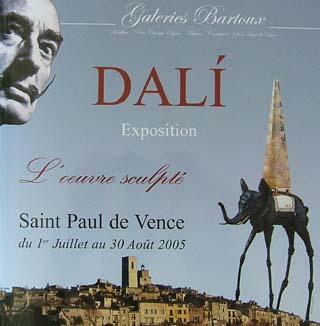 St Paul de Vence is perched on the top of a hill and enclosed by
ramparts
left from
the 16th century. To enter, you must walk down a narrow passage
directly towards a large cannon set into the wall. Despite this
dubious welcome it is littered with artists and galleries. In the
1920s it was a hangout for
the
likes of Signac, Modigliani, and Bonnard. It's reputation is
furthered by the close proximity to the Maeght foundation which was set
up to
help young artists get started but now seems mostly to promote the
famous. I'll have to verify that some day but for this
trip we just went to go see
an exhibit of Salvadore Dali's sculpture. (Post note: It
was set up to promote the Maeghts and their friends--some of whom were
made famous by the
Maeghts. On the other hand, it is a proudly self-motivated
institution in a country where culture and the state "la republique"
are nearly inseperable.)
St Paul de Vence is perched on the top of a hill and enclosed by
ramparts
left from
the 16th century. To enter, you must walk down a narrow passage
directly towards a large cannon set into the wall. Despite this
dubious welcome it is littered with artists and galleries. In the
1920s it was a hangout for
the
likes of Signac, Modigliani, and Bonnard. It's reputation is
furthered by the close proximity to the Maeght foundation which was set
up to
help young artists get started but now seems mostly to promote the
famous. I'll have to verify that some day but for this
trip we just went to go see
an exhibit of Salvadore Dali's sculpture. (Post note: It
was set up to promote the Maeghts and their friends--some of whom were
made famous by the
Maeghts. On the other hand, it is a proudly self-motivated
institution in a country where culture and the state "la republique"
are nearly inseperable.)Seeing a gallery full of Dali's bronzes pointed out one of the biggest difficulties of sculpture. Dali is one of my favorite painters because he was so skillful at creating believable depictions of a dream world. His sculpture is no less skillfully presented but in three dimensions it wasn't really surreal anymore. Instead, some of the important icons of his two-dimensional work were taken out of the dreamscape and placed into the real world. A bronze casting of a melted watch, draped over a bronze tree branch, in a gallery, with a price tag and surrounded by other bronze objects of familiar forms from Dali's work, all for sale, was terribly real. The setting was a gallery presenting famous work for wealthy clients and not the empty pastel plains of Dali's paintings. I fear that this question of "setting" will always be a limitation for sculpture.
Scale helps. Some of the Dali pieces were too big to fit in the gallery. For example, his "Space Elephant": some 29 feet tall and several tons of bronze supported on spindly legs on the 16th century ramparts of St Paul was surreal (Note: it was big but not quite as impressive as the image on the catalog at left). The similarly huge "Cosmic Rhinoceros" on the Coisette in Cannes in front of the Ritz Carlton and surrounded by tourists snapping photos was surreal. (Incidentally, the gigantic highway bridge "Pont Millau" and its driving deck supported 80 stories over the rural French countryside was also surreal.) The common factor seems to be the conflict between the work and the portion of the surrounding environment that is forced to be reconciled. In the case of Dali's Elephant and Rhino that "setting" was the confused tourists and several blocks of buildings in a city (in the case of Pont Millau it was kilometers of countryside).
My basic conclusion is that everything in view in any direction counts with sculpture. In that respect, two-dimensional work like a painting or this computer monitor has a big advantage because the viewer is accustomed to allowing the portion within the frame to be a window on a separate world.